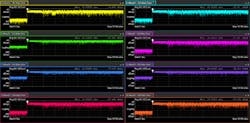What timing synchronization means for your multi-channel RF signal generation
In a rock band, the drummer keeps the beat steady and the other musicians follow the rhythm. The drummer keeps the entire band in sync. The same concept is true when you integrate multiple instruments into a test system. Synchronizing individual instruments needs to take place, especially when you are generating multi-channel RF signals. Like a drummer, a trigger and a reference clock communicate the “beat” to synchronize the instruments so they can make precise, time-aligned measurements. Let’s take a closer look at multi-channel signal generation and how to achieve an accurate multi-channel test setup.
MULTI-ANTENNA TECHNIQUES
As higher throughput applications grow sharply, wireless systems require wider bandwidth. Given limited spectrum allocation, engineers must look for a way to improve spectral efficiency. The wireless industry relies on a multi-antenna technique, multi-input, multi-output (MIMO), to improve spectral efficiency without increasing signal bandwidth. Generating multi-channel test signals requires a test system capable of providing precise timing alignment between the signals. Figure 1 illustrates 802.11ac MIMO with eight transmit channels; all signals transmit simultaneously.
KEYS TO SYNCHRONIZING MULTIPLE INSTRUMENTS
Synchronize multiple instruments with a trigger. Triggering is a coordination signal that routes to each instrument in a test setup. When instruments detect the trigger signal, they perform its task. However, there are two sources of error that you need to minimize.
1. Sampling clock
When a baseband generator receives a trigger signal, it will start playing waveforms from the rising edge of the next sampling clock. Even if sampling clock differences are tiny, they will accumulate over time and signals may not transmit at a different time. Using a common frequency reference, ensure all the signal generators have the same system clock. With the same sampling clock, all instruments may not start generating signals at the same time, but all the signals start at fixed time offsets. You may need to use additional timing alignment to remove the time offsets.
2. Trigger Delay
Cabling and external devices can affect how long it takes a trigger signal to reach each instrument. You need to account for trigger delay effect so your instruments can transmit and receive at the same time. Using a channel skew control on your master instrument allows for precise time synchronization between all channels. Figure 2 shows two arbitrary waveform generators (AWGs) and their synchronization setup. To remove the effects of master-to-slave delay, it is necessary to delay the signal generated by the master.
For example, Keysight MXG N5182B vector signal generators (VSGs) can be set up as shown in Figure 3 for synchronizing multiple baseband generators (BBG). The multiple BBG synchronization feature offers a system for synchronizing the waveform generation capability of up to 16 signal generators within a characteristic value of ± 8 ns between the master and the last slave. You can reduce the minor amount of delay (± 8 ns) further to picosecond resolution by using the I/Q Delay adjustment. The delay value includes compensation for cables that have less than 1 ns of propagation delay between the EVENT 1 and PAT TRIG connector. The use of cables with greater propagation delay may not allow the signal generators to properly synchronize. In addition, you will need to connect a frequency reference using daisy-chain topology.
TRIGGER AND TIME SYNCHRONIZATION LEADS TO BETTER TESTING
Eric Hsu is a product marketing manager at Keysight Technologies. He has over 18 years experience in wireless applications with Keysight (formerly Agilent Technologies).
This blog was originally posted by Keysight Technologies here





